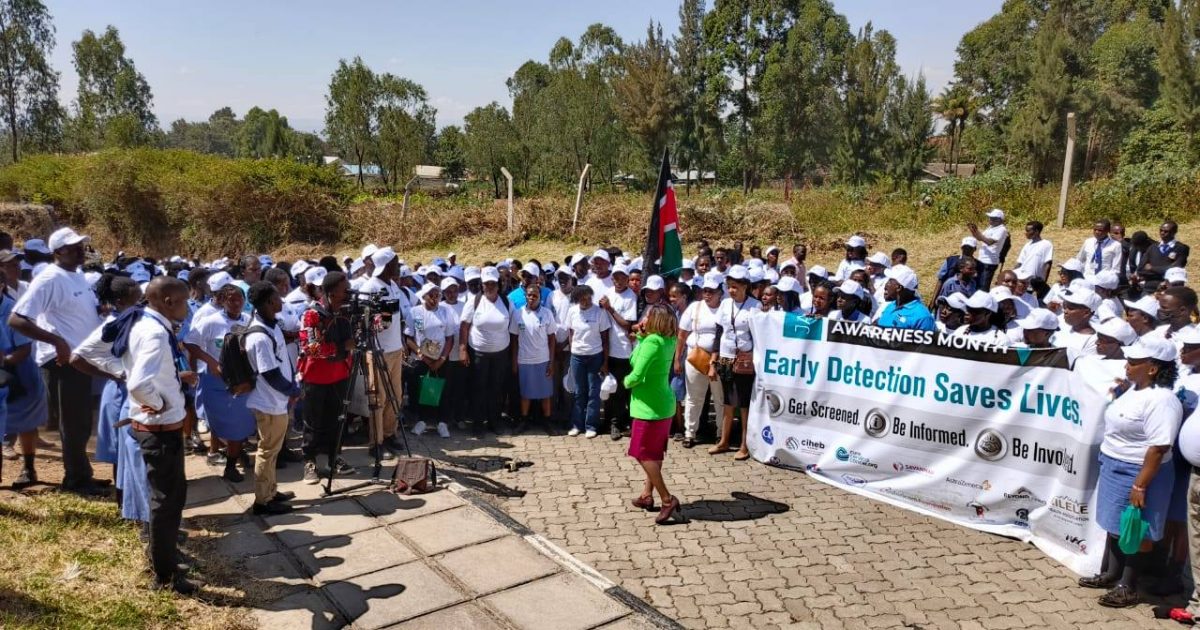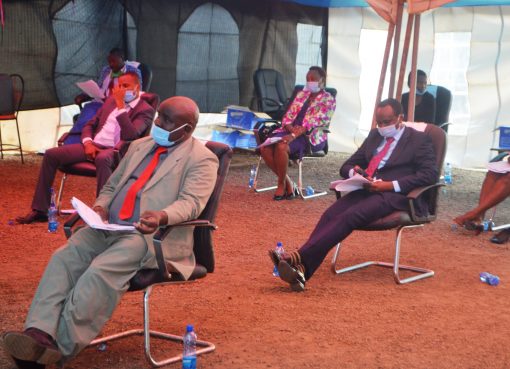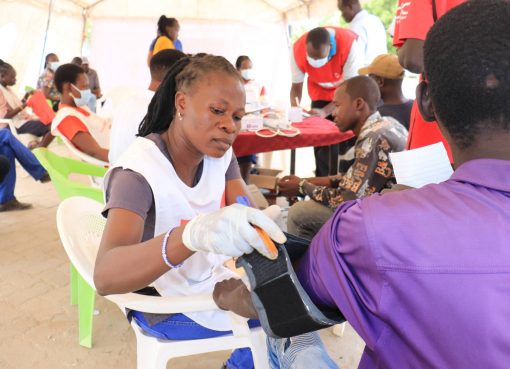Nine Kenyan women die of cervical cancer every day, yet the cancer burden can be reduced through early diagnosis and screening.
Faced with this challenge, the County Government of Nakuru has launched a month-long campaign to boost awareness of cervical cancer.
The devolved unit seeks to accelerate the elimination of cervical cancer in the region by reaching 1 million women and girls with information on screening and vaccination.
The County Executive for Health Services Roselyn Mungai while indicating that they were partnering with the National Cancer Institute (NCI) in the initiative announced that 15 level 4 public health care facilities, including the Nakuru Level 5 Teaching and Referral Hospital will offer free cervical and prostate cancer screenings throughout the week.
“Cervical cancer is a preventable and treatable disease, yet it continues to affect many women around the world, including Kenya. Despite advancements in medicine and the availability of vaccines, it’s unfortunate that more awareness and proactive measures aren’t in place to combat this issue. For many women, cervical cancer remains a serious threat due to a lack of information or access to necessary care,” she explained.
Mungai asked Kenyans to visit health facilities for regular screening for cervical cancer to ensure early detection.
January being Cervical Cancer Awareness month, the county executive affirmed that the County Government will use the opportunity to do more public awareness including in the churches, as a way of ensuring the information reaches a wider audience.
She noted that one of the primary ways to prevent cervical cancer is through regular screening and vaccination and asked parents to have their daughters vaccinated against the same.
The human papillomavirus (HPV) vaccine, which prevents the types of HPV that most commonly cause cervical cancer, has been shown to significantly reduce incidents of the disease.
Early detection through cervical screening allows for the identification and treatment of precancerous lesions before they develop into full-blown cancer.
Mungai stated that Governor Susan Kihika’s administration through the Community Health Promoters (CHPs) health has embarked on an awareness campaign targeting parents to embrace vaccination, adding that the vaccine is safe and no one should fear it. The CHPs, she said, would also work towards making the public understand the vaccine and its safety.
“There is a need for regular screening for early detection so that one can start treatment at the earliest stage in case one is diagnosed with cancer. Every girl below 15 years should be taken for vaccination while women between 25-50 years should go for screening,” the county executive noted.
She also used the opportunity to assure Kenyans that the Social Health Authority is working and no one will be left out in accessing health services.
Mungai expressed concern that studies have indicated that cervical cancer deaths will rise by 50 percent if stakeholders in the health sector do not act.
“We are concerned because 50 percent of Kenya’s workforce is made up of women. We want to ensure that our women continue working and contributing to the economy productively. However, they need to access screening and timely treatment so that we ultimately eliminate cervical cancer,” she noted.
The Ministry of Health indicates that only 16 percent of all eligible women aged between 25 and 49 have been screened for cervical cancer at some point in their lives, despite 75 percent being aware of the need for screening.
In 2019 the Ministry of Health introduced the Human Papilloma Virus (HPV) vaccine that protects against HPV types 16 and 18, which the World Health Organization (WHO) says cause at least 70 percent of cervical cancer.
The vaccination drive targets girls aged 9 to 14 years. The vaccine is administered in two doses, six months apart, and provides strong protection against the virus.
Nakuru County will host the National Commemoration of Cervical Cancer Awareness Month from January 20th to 24th, 2025.
Every year, about 5,236 Kenyan women are diagnosed with cervical cancer and about 60 per cent of them (3,211) die, according to the World Health Organization’s latest data. The number could be more, given that many cases go unreported.
The County Executive stated it was disturbing that some of the women were already burdened by HIV/Aids and poverty and were caught off guard by another disease that they know little about.
Cervical cancer is still shrouded in silence due to shame culture, lack of sex education and stigma around sexually transmitted illnesses.
Kenya has one of the highest rates globally, with 40 new cases of cervical cancer diagnosed per 100,000 women annually.
A health survey conducted towards the end of 2021 shows cervical cancer as the second most common cancer, after breast cancer, and the leading cause of cancer related deaths among women in Kenya, contributing to 5,336 new cases and 3,211 deaths annually.
“This is the second most common cancer among women worldwide after breast cancer and number one killer of women in in developing countries like Kenya,” said Mungai.
Data from Nairobi alone, from the cancer registry at the Kenya Medical Research Institute (KEMRI), indicates that cervical cancer accounts for between 20 to 25 percent of cancers reported in women in the period 2019 to 2022.
The figures are much higher nationally. The estimates by International Agency for Research on Cancer ((IARC) indicate that 2, 635 Kenyans aged between 15 and 65 develop cervical cancer, 65 percent of whom die of the disease.
Chairperson of the National Cancer Institute (NCI) Board Dr. Timothy Olweny elaborated that out of more than 200 strains of HPV, about 14 are considered high-risk for cervical cancer, with types 16 and 18 causing nearly 70% of cases worldwide.
He added that while most HPV infections clear up naturally within two years, some persist and cause changes in cervical cells that, if untreated, can develop into invasive cancer.
Cervical cancer is the fourth most common cancer among women globally. According to the World Health Organization (WHO), in 2022, an estimated 660,000 women were diagnosed with cervical cancer worldwide and about 350,000 women died from the disease.
Alarmingly, the highest incidence of these deaths occurred in low and middle-income countries where access to screening and treatment is limited.
Dr. Olweny asserted that most cancers were treatable if diagnosed early. She called on Kenyans to change their perception of the disease as a death sentence.
According to statistics by the Ministry of Health, the national uptake of screening stands at 16 percent.
He said there was a need to bridge the gap between screening and medication, adding that most cancer cases are diagnosed late when nothing much can be done.
Dr. Olweny explained that Kenyan women can no longer afford to ignore cervical cancer, which is among the most common forms of cancer.
“In Kenya, the burden is particularly heavy. Cervical cancer is the second most common cancer among women, after breast cancer, and it’s the leading cause of cancer-related deaths in women aged 15 to 44. According to the Kenya: Human Papillomavirus and Related Cancers, Fact Sheet 2023, annually, more than 5,200 women in Kenya are diagnosed with cervical cancer, and over 3,200 lose their lives to it,” he stated.
He added, “While HPV is the main cause, certain factors increase the risk of developing cervical cancer. Starting sexual activity at a young age increases exposure to the virus, and having multiple sexual partners raises the chances of contracting high-risk strains.”
Also, women with weakened immune systems, such as those living with HIV/AIDS, are particularly vulnerable to persistent infections. Smoking has also been linked to abnormal changes in cervical cells. Without regular screening, early-stage cervical cancer often goes unnoticed, as it develops silently without symptoms.
Dr. Olweny affirmed that pap smears, which detect abnormal cervical cells, are recommended every three years for women aged 21 to 65 and that for women aged 30 and above, HPV testing often combined with Pap smears is advised to identify high-risk infections early.
“Lifestyle choices can also help prevent cervical cancer. Practicing safe sex reduces the risk of HPV transmission while avoiding smoking lowers the chances of developing cervical abnormalities. Maintaining a healthy diet and exercising regularly can strengthen the immune system, offering additional protection against infections,” he elaborated.
In 2020, WHO launched the Cervical Cancer Elimination Initiative aimed to reduce the disease’s incidence to fewer than four cases per 100,000 women by 2030. This goal depends on vaccinating 90% of girls by age 15, screening 70% of women at least twice in their lives, and treating 90% of those diagnosed with cervical disease.
Chief Executive Officer of the National Cancer Institute Dr. Elias Melly emphasized the necessity of citizens’ voluntary screening and the importance of healthcare workers’ follow-up to ensure that positive test results are promptly addressed with treatment.
He expressed optimism that Kenya is making progress toward these targets. He added that efforts to expand vaccination coverage and improve access to screening services are ongoing, driven by collaborations between the government and non-governmental organizations. However, challenges remain, particularly in reaching rural and underserved areas.
“Cervical cancer doesn’t have to be a silent killer. By focusing on vaccination, regular screening, and education, we can empower women to take charge of their health and significantly reduce the impact of this preventable disease. Every woman deserves the chance to live free from the shadow of cervical cancer,” he observed.
In efforts to eliminate cervical cancer by 2030, governments should have fully vaccinated 90 percent of their girls by the age of 15 with the HPV vaccine outlined by the WHO in its global strategy for tackling the public health problem.
In addition, they should ensure 70 percent of women are screened at 35-45 years, while ensuring 90 percent of women identified with pre-cancer or invasive cervical cancer receive treatment.
Dr. Melly pointed out that it takes all facets of the Kenyan society to create a cervical free cancer future for current as well as generations to come.
By Jane Ngugi and Patience Moraa





